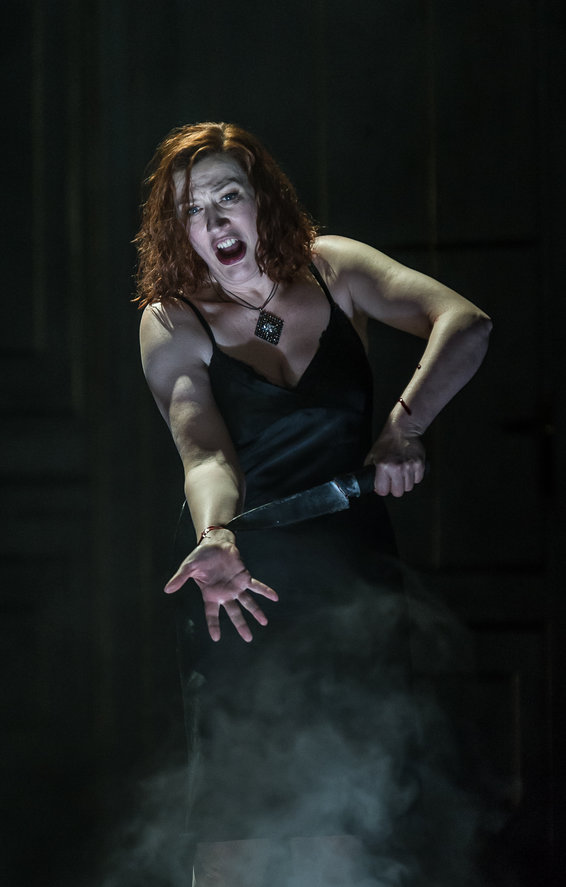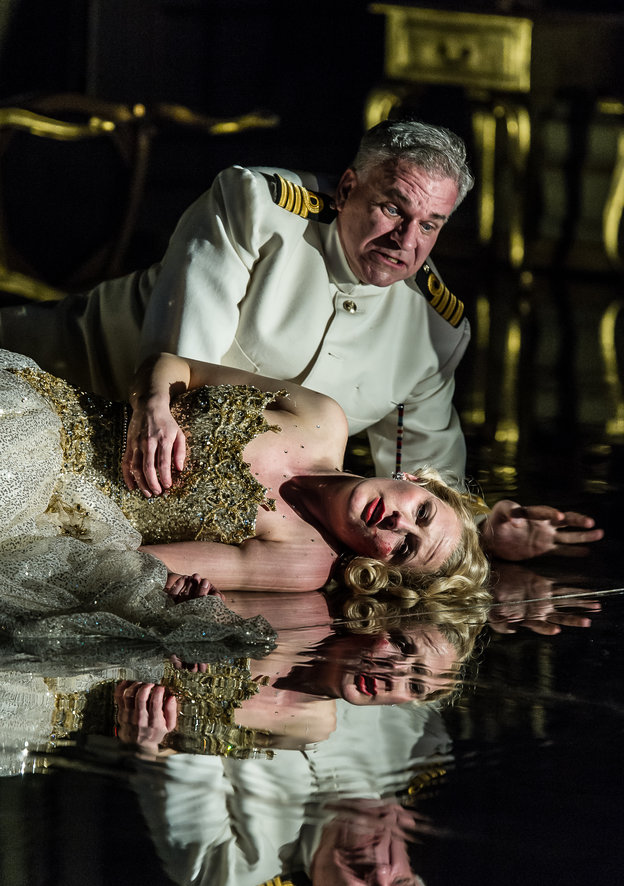Medea, English National Opera | reviews, news & interviews
Medea, English National Opera
Medea, English National Opera
Sarah Connolly and David McVicar lead a triumphant return to French baroque for ENO

How do you solve a problem like Medea? Euripides’ baby-killing, hell-invoking sorceress is one of literature’s most terrifying and unfathomable creations – a woman capable of murdering her own children just to watch their father’s pain. Yet with the blood on her hands now centuries-old, Medea continues to work her grim enchantments on artists.
With 2011’s Castor and Pollux English National Opera nudged a door ajar that has been closed on British stages for centuries. The baroque revival of the past few decades has been vigorous and ubiquitous, so long as your surname is Italian, or Handel. But the French baroque music of Lully, Rameau and Charpentier has remained exiled from the opera house, banished for its difficulty and dramatic otherness.
"Connolly's Medea is at once magnificent and horrifying"Freed from the recitative-aria conventions of Handel and Vivaldi, French composers enjoyed a much more fluid and dramatically sensitive form, drifting from dance to arioso to duet without the chains of the da capo aria to weight it down. It’s this freedom – at its most extreme in Charpentier’s Medea – that lends itself so naturally to those complex, cumulative emotions that struggle against the confines of Handel’s conventions.
Beauty here doesn’t come framed in a 10-minute aria, it has to be sought out in the detail: an unexpectedly thickly-harmonised cadence in the strings, a tugging appoggiatura that clings just longer than expected, a false relation that grinds the ear underfoot. Christian Curnyn conducts the ENO orchestra, coaxing a beautiful if sometimes rather muted blend from his contemporary strings and adding period colouring with some plangent work from recorders and theorbo.
 There will be those who would condemn the extended dance episodes to the chop, but dance is the heartbeat of French baroque and (barring some intrusively noisy footwork) is generously served here in a full-length masque and froths out of the drama throughout. Some of it is decidedly camp (director David McVicar seems briefly to stray into Jonathan Miller’s Mikado with his cavorting naval officers) and the Busby-Berkeley-meets-MTV cabaret won’t be to everyone’s taste, but Lynne Page’s choreography does ensure that all movement, however anachronistic, grows organically from the music. It’s a huge improvement on the recent calisthenic horrors of ENO’s recent Julius Caesar.
There will be those who would condemn the extended dance episodes to the chop, but dance is the heartbeat of French baroque and (barring some intrusively noisy footwork) is generously served here in a full-length masque and froths out of the drama throughout. Some of it is decidedly camp (director David McVicar seems briefly to stray into Jonathan Miller’s Mikado with his cavorting naval officers) and the Busby-Berkeley-meets-MTV cabaret won’t be to everyone’s taste, but Lynne Page’s choreography does ensure that all movement, however anachronistic, grows organically from the music. It’s a huge improvement on the recent calisthenic horrors of ENO’s recent Julius Caesar.
McVicar returns to his baroque roots here in a production colliding eras and worlds that is the natural heir to his Alcina or Agrippina. An 18th-century apartment finds itself requisitioned for use by the entire Allied forces of the 1940s, the fading shell of a gilded oligarchy hosting an invasion of privileged, patriarchal thugs. Plus ça change. Bunny Christie’s gloriously stylised costumes offer decorative contradiction to this era of emancipation in which the women still prance around in pencil-skirts and stilettos, gyrate in sequinned hot-pants, or waft fragrantly about in virginal white – fantasy-fodder for the military men.
A power-suited Sarah Connolly (pictured above right) stands apart. Her Medea chafes against the confines of her role and gender, exploited then discarded at the whim of a libidinous husband. Vocally dwarfing her colleagues, her struggle to repress herself into this world of social hierarchies is mirrored visually and musically. Forging her own path through Charpentier’s fluid tempo-transitions and moods, she never lets her hand slip from the psychological string that guides us through the endless corners and corridors of recit. Her miniature aria of grief once Jason’s abandonment is certain coaxes tears, while her final invocation of the forces of Hell partners that earlier fragility with a reckless blood-lust. We feel for her, even as we know the small, pyjama-clad bodies are coming, and in her final ascent (not descent, interestingly) to darkness she is at once magnificent and horrifying.
 Roderick Williams’ Orontes (brilliantly styled as a Lord Flashheart-esque RAF pilot) leads the supporting cast with swagger and glossy tone, balanced by the brighter colours of Jeffrey Francis’s Jason, whose characterisation sits more comfortably than his highest register, and whose rhythmic sensitivity occasionally wavers. Katherine Manley’s Creusa (pictured left with Francis as Jason) is a Hitchcock blonde with daddy-issues, channelling Grace Kelly circa To Catch a Thief in her styling and sparring intriguingly with Brindley Sherratt’s Creon. Hers is the most blossomy of the various excellent soprano voices on show (Rhian Lois’s Nerina also deserves mention), finding airy spaces for ambiguity and personality in her delivery. Her duet with Sophie Junker’s Phantom II is a highlight, as is her glorious death-duet with Francis.
Roderick Williams’ Orontes (brilliantly styled as a Lord Flashheart-esque RAF pilot) leads the supporting cast with swagger and glossy tone, balanced by the brighter colours of Jeffrey Francis’s Jason, whose characterisation sits more comfortably than his highest register, and whose rhythmic sensitivity occasionally wavers. Katherine Manley’s Creusa (pictured left with Francis as Jason) is a Hitchcock blonde with daddy-issues, channelling Grace Kelly circa To Catch a Thief in her styling and sparring intriguingly with Brindley Sherratt’s Creon. Hers is the most blossomy of the various excellent soprano voices on show (Rhian Lois’s Nerina also deserves mention), finding airy spaces for ambiguity and personality in her delivery. Her duet with Sophie Junker’s Phantom II is a highlight, as is her glorious death-duet with Francis.
The pace may take a while to pick up (and that with a huge cut early on), but once underway Charpentier’s Medea has all the momentum of its Greek original. The music won’t satisfy melody junkies or those craving high-wire coloratura thrills, but for social and individual psychology it leaves Handel still puzzling over the instruction manual for assembling his Freudian couch.
How do you solve a problem like Medea? Ask ENO – they seem to have found the answer.
rating
Buy
Explore topics
Share this article
The future of Arts Journalism
You can stop theartsdesk.com closing!
We urgently need financing to survive. Our fundraising drive has thus far raised £49,000 but we need to reach £100,000 or we will be forced to close. Please contribute here: https://gofund.me/c3f6033d
And if you can forward this information to anyone who might assist, we’d be grateful.

Subscribe to theartsdesk.com
Thank you for continuing to read our work on theartsdesk.com. For unlimited access to every article in its entirety, including our archive of more than 15,000 pieces, we're asking for £5 per month or £40 per year. We feel it's a very good deal, and hope you do too.
To take a subscription now simply click here.
And if you're looking for that extra gift for a friend or family member, why not treat them to a theartsdesk.com gift subscription?
more Opera
 La bohème, Opera North review - still young at 32
Love and separation, ecstasy and heartbreak, in masterfully updated Puccini
La bohème, Opera North review - still young at 32
Love and separation, ecstasy and heartbreak, in masterfully updated Puccini
 Albert Herring, English National Opera review - a great comedy with depths fully realised
Britten’s delight was never made for the Coliseum, but it works on its first outing there
Albert Herring, English National Opera review - a great comedy with depths fully realised
Britten’s delight was never made for the Coliseum, but it works on its first outing there
 Carmen, English National Opera review - not quite dangerous
Hopes for Niamh O’Sullivan only partly fulfilled, though much good singing throughout
Carmen, English National Opera review - not quite dangerous
Hopes for Niamh O’Sullivan only partly fulfilled, though much good singing throughout
 Giustino, Linbury Theatre review - a stylish account of a slight opera
Gods, mortals and monsters do battle in Handel's charming drama
Giustino, Linbury Theatre review - a stylish account of a slight opera
Gods, mortals and monsters do battle in Handel's charming drama
 Susanna, Opera North review - hybrid staging of a Handel oratorio
Dance and signing complement outstanding singing in a story of virtue rewarded
Susanna, Opera North review - hybrid staging of a Handel oratorio
Dance and signing complement outstanding singing in a story of virtue rewarded
 Ariodante, Opéra Garnier, Paris review - a blast of Baroque beauty
A near-perfect night at the opera
Ariodante, Opéra Garnier, Paris review - a blast of Baroque beauty
A near-perfect night at the opera
 Cinderella/La Cenerentola, English National Opera review - the truth behind the tinsel
Appealing performances cut through hyperactive stagecraft
Cinderella/La Cenerentola, English National Opera review - the truth behind the tinsel
Appealing performances cut through hyperactive stagecraft
 Tosca, Royal Opera review - Ailyn Pérez steps in as the most vivid of divas
Jakub Hrůša’s multicoloured Puccini last night found a soprano to match
Tosca, Royal Opera review - Ailyn Pérez steps in as the most vivid of divas
Jakub Hrůša’s multicoloured Puccini last night found a soprano to match
 Tosca, Welsh National Opera review - a great company reduced to brilliance
The old warhorse made special by the basics
Tosca, Welsh National Opera review - a great company reduced to brilliance
The old warhorse made special by the basics
 BBC Proms: The Marriage of Figaro, Glyndebourne Festival review - merriment and menace
Strong Proms transfer for a robust and affecting show
BBC Proms: The Marriage of Figaro, Glyndebourne Festival review - merriment and menace
Strong Proms transfer for a robust and affecting show
 BBC Proms: Suor Angelica, LSO, Pappano review - earthly passion, heavenly grief
A Sister to remember blesses Puccini's convent tragedy
BBC Proms: Suor Angelica, LSO, Pappano review - earthly passion, heavenly grief
A Sister to remember blesses Puccini's convent tragedy
 Orpheus and Eurydice, Opera Queensland/SCO, Edinburgh International Festival 2025 review - dazzling, but distracting
Eye-popping acrobatics don’t always assist in Gluck’s quest for operatic truth
Orpheus and Eurydice, Opera Queensland/SCO, Edinburgh International Festival 2025 review - dazzling, but distracting
Eye-popping acrobatics don’t always assist in Gluck’s quest for operatic truth

Add comment